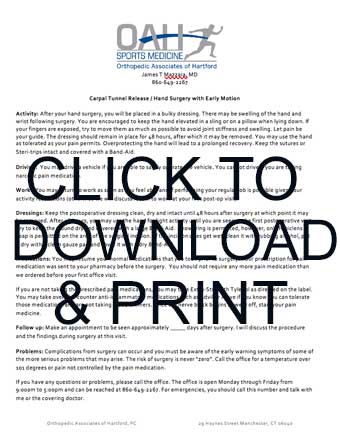Activity: After your ankle arthroscopy, you may be given crutches. These should be used until you are seen in the office. You may not put full weight on your leg after this surgery. Elevation of the leg is important for the first day after the surgery as it helps to reduce the leg swelling. After 1-2 days, if your ankle is feeling good, you may increase your activity level gradually.
Use ice packs to the ankle for the first 24-48 hours after surgery. Apply the ice as frequently as needed after surgery. After 24 hours, you may use the ice packs two or more times a day for 20 minutes at a time, if desired for comfort.
Dressings: The post op dressing should remain in place for 24 hours after surgery. It is normal to have small amounts of drainage of arthroscopy fluid with small amounts of blood on the dressing in the day after surgery. If the dressing feels too tight after the surgery, remove the Ace bandage and reapply it more loosely. Once the dressing is removed, clean the incisions with rubbing alcohol and cover the small incisions with Band-Aids after a shower. It is OK to get the arthroscopy incisions wet in a shower after 24 hours but do not soak them in bath water for one week. Re-wrap the leg with the ace bandage after the skin is dry. Only Hibiclens soap may be used on the surgical leg.
Driving: You may drive a vehicle after 24 hours if you are able to safely operate the vehicle. If your surgery was on your left ankle and you have a car with an automatic transmission, you should be mechanically able to perform the functions associated with normal driving. If your surgery was on your right ankle, you may not drive until we discuss the surgery and necessary restrictions in the office. You cannot drive if you are taking narcotic pain medication.
Work: You may return to work as soon as you feel able and performing your regular job is possible given your activity restrictions. Remember, you may not weight-bear on the ankle until we discuss the surgery at the first post-operative visit.
Medications: You may resume your normal medications that you took prior to surgery. Your prescription for pain medication was sent to your pharmacy before the surgery. You should not require any more pain medication than we ordered before your first office visit.
If you are not taking the prescribed pain medications, you may take Extra-Strength Tylenol as directed on the label. You may take over-the-counter anti-inflammatory medications such as Advil or Aleve if you know you can tolerate those medications and are not taking blood thinners. Once the nerve block begins to wear off, start your pain medicine.
Unless you are allergic, take one aspirin 81mg twice per day to reduce the chances of blood clots. Blood clots may occur after any surgery or injury to the leg and may be associated with complaints of calf pain, calf cramping, pain in back of the knee, chest pain or shortness of breath.
Follow up: Make an appointment to be seen approximately one week after surgery. I will discuss the procedure and the findings during surgery at this visit.
Problems: Complications from ankle surgery can occur and you must be aware of the early warning symptoms of some of the more serious problems that may arise. The risk of surgery is never “zero”.
Call the office for a temperature over 101 degrees, pain not controlled by the pain medication, or drainage from the incision that lasts more than 24 hours or calf pain, chest pain, or shortness of breath.
